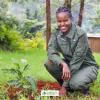With new technologies revolutionizing data collection, wildlife researchers are becoming increasingly able to collect data at much higher volumes than ever before. Now we are facing the challenges of putting this information to use, bringing the science of big data into the conservation arena. With the help of machine learning tools, this area holds immense potential for conservation practices. The applications range from online trafficking alerts to species-specific early warning systems to efficient movement and biodiversity monitoring and beyond.
However, the process of building effective machine learning tools depends upon large amounts of standardized training data, and conservationists currently lack an established system for standardization. How to best develop such a system and incentivize data sharing are questions at the forefront of this work. There are currently multiple AI-based conservation initiatives, including Wildlife Insights and WildBook, that are pioneering applications on this front.
This group is the perfect place to ask all your AI-related questions, no matter your skill level or previous familiarity! You'll find resources, meet other members with similar questions and experts who can answer them, and engage in exciting collaborative opportunities together.
Just getting started with AI in conservation? Check out our introduction tutorial, How Do I Train My First Machine Learning Model? with Daniel Situnayake, and our Virtual Meetup on Big Data. If you're coming from the more technical side of AI/ML, Sara Beery runs an AI for Conservation slack channel that might be of interest. Message her for an invite.
Header Image: Dr Claire Burke / @CBurkeSci

Explore the Basics: AI
Understanding the possibilities for incorporating new technology into your work can feel overwhelming. With so many tools available, so many resources to keep up with, and so many innovative projects happening around the world and in our community, it's easy to lose sight of how and why these new technologies matter, and how they can be practically applied to your projects.
Machine learning has huge potential in conservation tech, and its applications are growing every day! But the tradeoff of that potential is a big learning curve - or so it seems to those starting out with this powerful tool!
To help you explore the potential of AI (and prepare for some of our upcoming AI-themed events!), we've compiled simple, key resources, conversations, and videos to highlight the possibilities:
Three Resources for Beginners:
- Everything I know about Machine Learning and Camera Traps, Dan Morris | Resource library, camera traps, machine learning
- Using Computer Vision to Protect Endangered Species, Kasim Rafiq | Machine learning, data analysis, big cats
- Resource: WildID | WildID
Three Forum Threads for Beginners:
- I made an open-source tool to help you sort camera trap images | Petar Gyurov, Camera Traps
- Batch / Automated Cloud Processing | Chris Nicolas, Acoustic Monitoring
- Looking for help with camera trapping for Jaguars: Software for species ID and database building | Carmina Gutierrez, AI for Conservation
Three Tutorials for Beginners:
- How do I get started using machine learning for my camera traps? | Sara Beery, Tech Tutors
- How do I train my first machine learning model? | Daniel Situnayake, Tech Tutors
- Big Data in Conservation | Dave Thau, Dan Morris, Sarah Davidson, Virtual Meetups
Want to know more about AI, or have your specific machine learning questions answered by experts in the WILDLABS community? Make sure you join the conversation in our AI for Conservation group!
- @Tysmucker
- | He/Him
Wildlife Biologist/Conflict Specialist and drone enthusiast in Montana
- 0 Resources
- 0 Discussions
- 5 Groups

- 0 Resources
- 0 Discussions
- 4 Groups
Tropical ecologist working on community ecology and citizen science with ants as main research models
- 0 Resources
- 0 Discussions
- 5 Groups
- @iska1818
- | iska
nature nerd, leopard and eagle lover
- 0 Resources
- 0 Discussions
- 7 Groups
- 0 Resources
- 1 Discussions
- 3 Groups
- @roboticscats
- | He / him / his
Founder & CEO of RoboticsCats, a machine vision startup. Our AI wildfire detection SaaS is protecting forests & communities in Asia, Europe & LATAM.
- 0 Resources
- 1 Discussions
- 3 Groups
- @kalado
- | Kalado
I am Brazilian and a software developer. I have 20 years of experience in the field and I am currently the CTO of Log Nature, a company specialized in creating solutions for the environmental sector.
- 0 Resources
- 1 Discussions
- 8 Groups
I work in conservation on integrating the technology out there for custom solutions for partners.
- 0 Resources
- 0 Discussions
- 23 Groups
Postdoc researcher -- engineering for biodiversity conservation
- 0 Resources
- 1 Discussions
- 1 Groups
- @adanger24
- | She/Her
Arribada Initiative
Senior Project Manager and Field Specialist


- 2 Resources
- 16 Discussions
- 10 Groups
- @Samiul
- | He/His/Him
Wildlife Conservation Society (WCS)
Working for wildlife conservation in Bangladesh since 2010.
- 0 Resources
- 0 Discussions
- 2 Groups
- @kklibra
- | He
A biodiversity specialist with a penchant for using data, tools and applications for conservation and management of wildlife. That's IT.

- 0 Resources
- 0 Discussions
- 3 Groups
The Innovation in Practice edition of Methods in Ecology and Evolution is still seeking proposals about conservation technology
6 March 2023
Article
Rainforest Connection (RFCx) is bringing back the Arbimon newsletter for 2023! We're excited to share new features and tools of the platform, what's coming up, and some insights into our projects on bioacoustic...
23 February 2023
New technology enabling the automated monitoring of moths has been put to rigorous testing in tropical conditions in Panama by an international team of researchers
22 February 2023
Researchers and conservationists are embarking on a bold initiative to save the world's most trafficked wild mammal — the pangolin
16 February 2023
A machine learning-based solution that can segment the Prosomes and Lipid sacs with sufficient accuracy helps to recognize the ecological plasticity of key Arctic copepods. It allows scientists to learn more about the...
15 February 2023
A pilot program in Oregon’s Willamette Valley will test how well artificial intelligence-enabled sensors can identify and characterize wildfires, which will help with responder resource allocation and boost community...
15 February 2023
Technology to End the Sixth Mass Extinction. Salary: $104k-144K; Location: Washington DC or Seattle WA, potential hybrid; 5+ years of Full stack development experience; Deadline March 15th - view post for full job...
10 February 2023
Careers
The British Antarctic Survey’s Artificial Intelligence Lab is looking to hire a machine learning engineer/researcher.
10 February 2023
You will develop and apply novel approaches and machine learning techniques for the detection, classification and identification of marine fauna from passive acoustic monitoring (PAM) validated with paired visual...
10 February 2023
Careers
On the AST Skylight team, you will work with talented engineers, domain experts, and product managers to uncover illegal fishing by developing the tools that help countries around the globe combat this problem.
10 February 2023
Hi! I created a new tutorial video on how to annotate high density acceleration data using Firetail 10 (www.firetail.de). In particular, I cover * how to automatically segment your data * how to edit and modify...
8 February 2023
June 2025
event
July 2025
October 2025
event
event
September 2023
event
August 2023
73 Products
Recently updated products
16 Products
Recently updated products
| Description | Activity | Replies | Groups | Updated |
|---|---|---|---|---|
| Really interesting, I will take a look |
|
AI for Conservation, Camera Traps, Data management and processing tools, Emerging Tech | 9 months 3 weeks ago | |
| Great new!! |
+15
|
AI for Conservation | 9 months 3 weeks ago | |
| Hi Carly, thank you for the advice! I am only focusing on the two birds for now - my goal is to use part of the iNaturalist data I have pulled to train the model and the rest to... |
|
AI for Conservation | 9 months 3 weeks ago | |
| Thank you so much! Now everything is in the hands of amazing organizations and companies! But the first results of the Disaster Management cohort are bringing a very optimistic... |
|
AI for Conservation, Climate Change, Early Career, East Africa Community, eDNA & Genomics, Emerging Tech, Ending Wildlife Trafficking Online, Human-Wildlife Conflict, Open Source Solutions | 9 months 3 weeks ago | |
| great! |
|
AI for Conservation | 9 months 3 weeks ago | |
| interesting!!! |
|
AI for Conservation, Animal Movement, Data management and processing tools | 9 months 3 weeks ago | |
| so great!!! |
|
Software Development, AI for Conservation, Animal Movement | 9 months 3 weeks ago | |
| @bluevalhalla thanks for sharing the awesome video, sounds like a great project! |
|
AI for Conservation | 9 months 3 weeks ago | |
| Hi everyone, I am conducting a research project as part of my MSc in Environment and Development at the London School of Economics. I... |
|
Acoustics, AI for Conservation, Autonomous Camera Traps for Insects, Ethics of Conservation Tech | 10 months ago | |
| @cmwainaina please take a look |
|
Animal Movement, AI for Conservation, Camera Traps, Connectivity, Data management and processing tools, East Africa Community, Emerging Tech, Ethics of Conservation Tech, Human-Wildlife Conflict, Marine Conservation, Protected Area Management Tools, Geospatial, Sensors, Software Development | 10 months ago | |
| Glad to announce that a new tutorial is available on Firetail: |
|
AI for Conservation, Animal Movement | 10 months 2 weeks ago | |
| The use of synthetic training data such as interpolated sequence values is common, but fraught with the issue of your synthetic signal generating features that are not true to... |
|
Data management and processing tools, AI for Conservation | 10 months 3 weeks ago |

















































